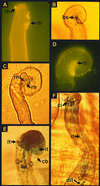Molecular basis of symbiotic promiscuity
- PMID: 10704479
- PMCID: PMC98991
- DOI: 10.1128/MMBR.64.1.180-201.2000
Molecular basis of symbiotic promiscuity
Abstract
Eukaryotes often form symbioses with microorganisms. Among these, associations between plants and nitrogen-fixing bacteria are responsible for the nitrogen input into various ecological niches. Plants of many different families have evolved the capacity to develop root or stem nodules with diverse genera of soil bacteria. Of these, symbioses between legumes and rhizobia (Azorhizobium, Bradyrhizobium, Mesorhizobium, and Rhizobium) are the most important from an agricultural perspective. Nitrogen-fixing nodules arise when symbiotic rhizobia penetrate their hosts in a strictly controlled and coordinated manner. Molecular codes are exchanged between the symbionts in the rhizosphere to select compatible rhizobia from pathogens. Entry into the plant is restricted to bacteria that have the "keys" to a succession of legume "doors". Some symbionts intimately associate with many different partners (and are thus promiscuous), while others are more selective and have a narrow host range. For historical reasons, narrow host range has been more intensively investigated than promiscuity. In our view, this has given a false impression of specificity in legume-Rhizobium associations. Rather, we suggest that restricted host ranges are limited to specific niches and represent specialization of widespread and more ancestral promiscuous symbioses. Here we analyze the molecular mechanisms governing symbiotic promiscuity in rhizobia and show that it is controlled by a number of molecular keys.
Figures



References
-
- Akkermans A D L, van Dijk C. Non-leguminous root-nodule symbiosis with actinomycetes and Rhizobium. In: Broughton W J, editor. Nitrogen fixation. 1. Ecology. Oxford, United Kingdom: Oxford University Press; 1981. pp. 57–103.
-
- Ardourel M, Demont N, Debellé F, Maillet F, DeBilly F, Promé J-C, Dénarié J, Truchet G. Rhizobium meliloti lipooligosaccharide nodulation factors: different structural requirements for bacterial entry into target root hair cells and induction of plant symbiotic developmental responses. Plant Cell. 1994;6:1357–1374. - PMC - PubMed
-
- Banfalvi Z, Kondorosi Á. Production of root hair deformation factors by Rhizobium meliloti nodulation genes in Escherichia coli: HsnD (NodH) is involved in the plant-specific modification of the NodABC factor. Plant Mol Biol. 1989;13:1–12. - PubMed
-
- Bassam B J, Djordjevic M A, Redmond J W, Batley M, Rolfe B G. Identification of a nodD-dependent locus in the Rhizobium strain NGR234 activated by phenolic factors secreted by soybeans and other legumes. Mol Plant-Microbe Interact. 1988;1:161–168. - PubMed
Publication types
MeSH terms
Substances
LinkOut - more resources
Full Text Sources

